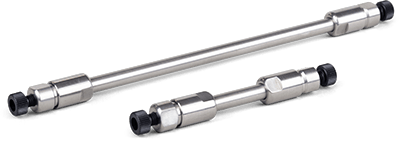
Size Exclusion Chromatography (SEC)
Size Exclusion Chromatography (SEC) is a chromatographic method which separates analytes solely based on their size, where molecules are separated on the basis of their exclusion from pores in the column packing material. Larger analytes will elute first, while the smaller molecules interact more with the stationary phase and will elute later.
Based on the analytes and the mobile phases used, size exclusion chromatography can be broken into two main categories, aqueous size exclusion/gel filtration chromatography (GFC) and non-aqueous size exclusion/gel permeation chromatography (GPC).
Aqueous Size Exclusion/ Gel Filtration Chromatography (GFC)
Analyze and/or characterize proteins, peptides, and other biomolecules such as antibodies, immunoglobulins, protein complexes, protein aggregates, and desalting.
Non-Aqueous Size Exclusion/ Gel Permeation Chromatography (GPC)
Analyze polymers such as adhesives, oils, plasticizers, plastics, resins, and rubbers/elastomers.
Size Exclusion Chromatography Column
Enhance your analytical capabilities with Phenomenex's advanced HPLC SEC columns, specifically designed for size exclusion chromatography. Our size exclusion columns deliver precise molecular size analysis, ensuring accurate results in analytical size exclusion chromatography. Explore the efficiency and reliability of Phenomenex's HPLC SEC technology, tailored to meet the demands of your chromatographic separations..
How does size exclusion chromatography work?
SEC employs porous beads (typically made of dextran, agarose, or polyacrylamide) packed into a column. These beads contain pores of specific sizes, creating a molecular "sieve." Large molecules cannot enter the pores and flow around the beads, eluting first in the void volume of the size exclusion chromatography column. Intermediate molecules partially enter the pores, leading to delayed elution based on their size. Small molecules fully penetrate the pores, taking the longest path and eluting last. This results in an elution order from largest to smallest molecular size (or weight).
When is the right time to use analytical size exclusion chromatography?
Analytical size exclusion chromatography is primarily used when separation and characterization of biomolecules or polymers based on size are required, particularly in scenarios demanding high-resolution analysis without chemical interactions. Analytical SEC is primarily employed to assess sample quality or study biomolecular properties.
Choosing the right column for analytical size-exclusion chromatography is crucial for achieving optimal separation and analysis of biomolecules.













